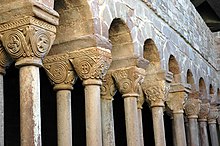Santa Maria de l'Estany Monastery
The monastery of Santa Maria de l'Estany is a former Augustinian canon in L'Estany , a municipality in the province of Barcelona in the Spanish autonomous region of Catalonia . Most of the church dates from the 12th century. Of particular importance is the completely preserved Romanesque cloister , which was built in the 12th and 13th centuries. In 1931 the monastery dedicated to the Virgin Mary was declared a monument ( Bien de Interés Cultural ).
history
Already in the middle of the 10th century there was a church in Estany - probably on the site of the current monastery building. The first written mention of the monastery dates back to 1080, when the bishop of Vic , Sunifred de Lluçà (1078-1099), settled there Augustinian canons from the Cathedral of Vic . The monastery, endowed with rich donations and lands in today's comarcas Bages and Osona , came to power and influence and founded or reformed other monasteries in the area. It was first referred to as an abbey in 1110 . This was probably the reason for the construction of today's church, which was consecrated in 1133. The cloister was built in the following years, although it was not completed until the 13th century. In 1264 the elevation to the abbey was confirmed.
The decline began as early as the 14th century and the monastery buildings began to decline. In 1448 an earthquake caused major damage and partially destroyed the church. From 1467 the monastery was subordinated to Kommendatarabten . In 1592 it was converted into a monastery for secular canons and dissolved in 1775. The church then served as the parish church for the place that was built in the vicinity of the monastery. The name Estany is reminiscent of a lake or pond that was drained by the Augustinian monks in 1554.
Extensive restoration work was carried out between 1966 and 1970. In 1984 a second floor was built in the cloister.
architecture
church
The single nave nave and apse of the 12th century church have been preserved, in the middle of which there is an arched window framed by archivolts and slender columns with capitals . A cornice made of a double row of round bars runs under the roof of the apse . Halfway up the outer wall, a chessboard frieze , which goes around the apse window above, extends over all three apses. The two apses on the transept arms are reconstructions from the time of restoration in the 1960s. The bell tower and the dome over the crossing were rebuilt after earthquakes in the 15th century.
On the west facade is the portal , which is bordered by unadorned vaulted stones. A large round window opens above the portal. A Gothic portal leads into the cloister on the south side .
Cloister
The cloister forms a square with a side length of ten meters. Each gallery consists of ten arched arcades supported by nine double columns. The corners are each occupied with five columns. The columns stand on an unusually high base and are decorated with intricately carved, truncated pyramid-shaped capitals. The total of 72 capitals are attributed to different workshops.
North gallery
The north gallery was built from the middle of the 12th century, its capitals are the oldest. The sculptural decoration is dedicated to themes from the Old and New Testament . Adam and Eve and the fall of man can be recognized, the proclamation and the visitation of Mary, episodes from the childhood of Jesus, the baptism of Jesus in the Jordan, the wedding at Cana , the temptation of Jesus and scenes from the story of the passion are shown.
West gallery
The capitals of the west wing have ornamental motifs, palmettes and foliage, animals and mythical creatures. Occasionally people are also shown, as well as a wild boar and a falcon hunt and a fight with a bear.
East gallery
On the capitals of the east gallery, next to palmettes and other foliage, you can see a young girl combing her hair, a pair of lovers embracing, a wedding, a man playing on a Rebec , a lute-like instrument, a woman who dances and beats castanets . On other capitals you can see lions, griffins, birds and an ox that is also playing on a Rebec. The Annunciation scene is depicted on one capital, another is depicted as a Pantocrat .
South gallery
A capital of the southern gallery shows two people holding a hare. Another is adorned with a medallion in the middle of which a knight on a horse and the coat of arms from the House of Folch de Cardona can be seen.
See also
In the hilly region of Pla de Bages , which is almost completely enclosed by mountains, there are two other medieval monasteries:
- Santa Maria de Montserrat (in the south)
- Sant Benet de Bages (in the center)
literature
- Jaime Cobreros: Las Rutas del Románico en España . Vol. II, Madrid 2004, ISBN 84-9776-112-X , pp. 92-94.
- Joan Ainaud de Lasarte: Catalogne novels . 3rd edition, La Pierre-qui-Vire (Zodiaque) 1994, ISBN 2-7369-0208-4 , pp. 171-211.
Web links
- Monestir de Santa Maria de l'Estany. In: Inventory of the historical buildings. Generalitat de Catalunya, accessed May 22, 2013 (Catalan).
- Monasterio de Santa Maria de l'Estany Monasterios de Catalunya, accessed May 22, 2013 (Spanish)
- Monasterio de Santa María de L'Estany, Barcelona www.arteguias.com, accessed December 19, 2014 (Spanish)
- Monestir Santa Maria de l'Estany accessed on May 22, 2013 (Spanish)
Coordinates: 41 ° 52 ′ 9.7 " N , 2 ° 6 ′ 45.2" E








